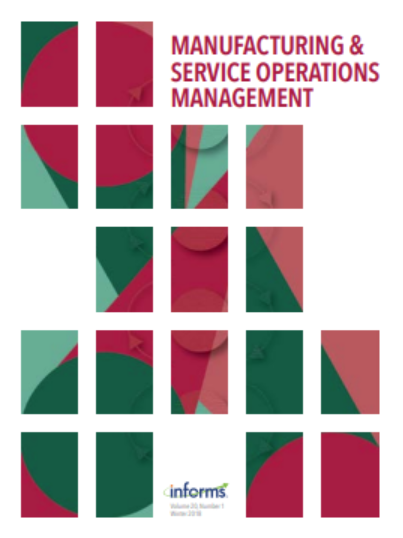Food Safety Audits in Developing Economies: Decentralization vs. Centralization
IF 4.2
3区 管理学
Q1 MANAGEMENT
引用次数: 3
Abstract
Problem definition: This paper investigates and compares two types of food safety auditing structures: decentralized and centralized audits. Academic/practical relevance: Decentralized food safety auditing systems are common among developing economies, that is, different tiers of a food supply chain are audited by separate government agencies. Such an auditing structure has been widely criticized as ineffective at mitigating food safety risks. Some developing countries began implementing centralized auditing systems as a remedy for the mis-coordination across local auditing agencies. We compare food safety outcomes and economical payoffs of the two auditing systems. Methodology: We study a parsimonious game-theoretic model of a one-supplier, one-buyer supply chain and two agencies auditing each tier of the supply chain, respectively. Under decentralized audits, each of the two agencies minimizes its individual cost, and their decisions are sequential; under centralized audits, the agencies minimize total agency cost and make auditing commitment up front. Results: We identify forces that drive equilibrium decisions under decentralized audits. The penalty-shield effect of an agency’s auditing capability may lead to risky behavior by the supplier. The free-riding effect between the two agencies may lead to less auditing. A centralized commitment makes the agencies the leader in the game at the expense of them losing the flexibility to respond to the actions of supply chain members. The common objective under centralization strengthens the incentives for at least one agency to conduct an audit, but it may also induce the lower-cost, less-capable agency to audit. Hence, centralized audits can be detrimental to performance regarding both food safety outcomes and system payoff. Managerial implications: Changing the auditing structure from decentralization to centralization may fail to improve food safety and system payoff insofar as it may replace one form of inefficiency with another. Addressing the new inefficiencies should be part of the ongoing effort to enhance the efficacy of centralized audits.发展中经济体的食品安全审计:分权vs集权
问题定义:本文调查并比较了两种类型的食品安全审计结构:分散审计和集中审计。学术/实践相关性:分散的食品安全审计系统在发展中经济体中很常见,也就是说,食品供应链的不同层次由不同的政府机构进行审计。这种审计结构被广泛批评为在降低食品安全风险方面无效。一些发展中国家开始实施集中审计制度,以弥补地方审计机构之间的不当协调。我们比较了两种审计系统的食品安全结果和经济效益。方法:我们研究了一个供应商、一个买方供应链和两个机构分别审计供应链每一层的简约博弈论模型。在分散审计下,这两个机构中的每一个都将各自的成本降至最低,而且它们的决定是顺序的;在集中审计下,审计机构最大限度地降低总代理成本,并提前作出审计承诺。结果:我们确定了在分散审计下推动均衡决策的力量。机构审计能力的惩罚屏蔽效应可能导致供应商的风险行为。这两个机构之间的搭便车效应可能会导致审计减少。集中的承诺使机构成为游戏中的领导者,但代价是它们失去了对供应链成员行为做出反应的灵活性。集中化下的共同目标加强了至少一个机构进行审计的动机,但也可能导致成本较低、能力较差的机构进行审计。因此,集中审计可能对食品安全结果和系统回报方面的绩效不利。管理含义:将审计结构从分散改为集中可能无法提高食品安全和系统回报,因为它可能会用另一种形式取代一种形式的低效。解决新的效率低下问题应成为正在进行的努力的一部分,以提高集中审计的效力。
本文章由计算机程序翻译,如有差异,请以英文原文为准。
求助全文
约1分钟内获得全文
求助全文
来源期刊

M&som-Manufacturing & Service Operations Management
管理科学-运筹学与管理科学
CiteScore
9.30
自引率
12.70%
发文量
184
审稿时长
12 months
期刊介绍:
M&SOM is the INFORMS journal for operations management. The purpose of the journal is to publish high-impact manuscripts that report relevant research on important problems in operations management (OM). The field of OM is the study of the innovative or traditional processes for the design, procurement, production, delivery, and recovery of goods and services. OM research entails the control, planning, design, and improvement of these processes. This research can be prescriptive, descriptive, or predictive; however, the intent of the research is ultimately to develop some form of enduring knowledge that can lead to more efficient or effective processes for the creation and delivery of goods and services.
M&SOM encourages a variety of methodological approaches to OM research; papers may be theoretical or empirical, analytical or computational, and may be based on a range of established research disciplines. M&SOM encourages contributions in OM across the full spectrum of decision making: strategic, tactical, and operational. Furthermore, the journal supports research that examines pertinent issues at the interfaces between OM and other functional areas.
 求助内容:
求助内容: 应助结果提醒方式:
应助结果提醒方式:


